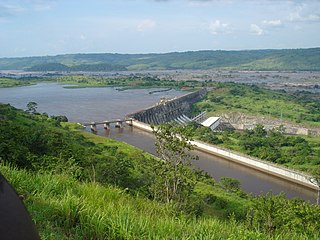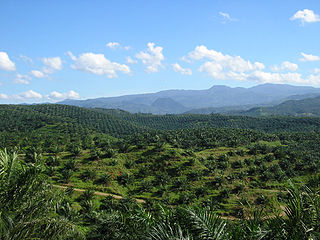
The economy of Malaysia is the fifth largest in Southeast Asia and the 38th largest in the world in terms of GDP. The 2018 labour productivity of Malaysia was measured at Int$55,360 per worker, the third highest in ASEAN. The 2021 Global Competitiveness Report ranked Malaysian economy the 25th most competitive country economy in the world.

Many countries and territories have installed significant solar power capacity into their electrical grids to supplement or provide an alternative to conventional energy sources. Solar power plants use one of two technologies:
Wind power is a form of renewable energy in Pakistan which makes up more than 6% of the total electricity production in the country. As of 2018, wind power capacity in Pakistan was 1,287 MW. The government is looking to increase the share of renewable energy and plans to add around 3.5 GW of wind energy capacity by 2018.

China–Pakistan relations, also referred to as Sino–Pak relations, refers to the bilateral relations between the Islamic Republic of Pakistan and the People's Republic of China (PRC). Formal relations between China and Pakistan were established in 1950, when the Dominion of Pakistan was among the first countries to sever diplomatic relations with the Republic of China (ROC) government in favour of recognizing the PRC as the legitimate "China". Since then, relations between the two countries have been extremely cordial for more than half a century, which are influenced by their similar geopolitical interests. Both countries have placed considerable importance on the maintenance of a "special relationship" between them, and their regular exchanges of high-level visits have culminated in the establishment of various cooperative measures. China has provided economic, technical, and military assistance to Pakistan; both sides regard each other as close strategic allies.
For solar power, South Asia has the ideal combination of both high solar insolation and a high density of potential customers.

China is the largest market in the world for both photovoltaics and solar thermal energy. China's photovoltaic industry began by making panels for satellites, and transitioned to the manufacture of domestic panels in the late 1990s. After substantial government incentives were introduced in 2011, China's solar power market grew dramatically: the country became the world's leading installer of photovoltaics in 2013. China surpassed Germany as the world's largest producer of photovoltaic energy in 2015, and became the first country to have over 100 GW of total installed photovoltaic capacity in 2017.

eSolar is a privately held company that develops concentrating solar power (CSP) plant technology. The company was founded by the Pasadena-based business incubator Idealab in 2007 as a developer of CSP plant technology. The company aims to develop a low cost alternative to fossil fuels through a combination of small heliostats, modular architecture, and a high-precision sun-tracking system. In October 2017, an article in GreenTech Media suggested that eSolar ceased business in late 2016.

The Democratic Republic of the Congo was a net energy exporter in 2008. Most energy was consumed domestically in 2008. According to the IEA statistics the energy export was in 2008 small and less than from the Republic of Congo. 2010 population figures were 3.8 million for the RC compared to CDR 67.8 Million.

Deforestation in Indonesia involves the long-term loss of forests and foliage across much of the country; it has had massive environmental and social impacts. Indonesia is home to some of the most biologically diverse forests in the world and ranks third in number of species behind Brazil and the Democratic Republic of Congo.

Pakistan has some of the highest values of insolation in the world, with eight to nine hours of sunshine per day, ideal climatic conditions for solar power generation. However, the country has been slow to adopt the technology. Despite electricity tariffs in Pakistan being some of highest in the world, total solar power installed capacity in Pakistan was only 568 MWAC in 2022.

Energy in Afghanistan is provided by hydropower followed by fossil fuel and solar power. Currently, less than 50% of Afghanistan's population has access to electricity. This covers the major cities in the country. Many rural areas do not have access to adequate electricity but this should change after the major CASA-1000 project is completed.

Energy in Singapore describes energy related issues in Singapore, which is a developed country located in Southeast Asia. Energy exports to others are about three times the primary energy supplied in the country itself. Additionally, oil imports in relation to the population demands of the country itself are concerningly high.

In 2019, the total energy production in Indonesia is 450.79 Mtoe, with a total primary energy supply is 231.14 Mtoe and electricity final consumption is 263.32 TWh. Energy use in Indonesia has been long dominated by fossil resources. Once a major oil exporter in the world and joined OPEC in 1962, the country has since become a net oil importer despite still joined OPEC until 2016, making it the only net oil importer member in the organization. Indonesia is also the fourth-largest biggest coal producer and one of the biggest coal exporter in the world, with 24,910 million tons of proven coal reserves as of 2016, making it the 11th country with the most coal reserves in the world. In addition, Indonesia has abundant renewable energy potential, reaching almost 417,8 gigawatt (GW) which consisted of solar, wind, hydro, geothermal energy, ocean current, and bioenergy, although only 2,5% have been utilized. Furthermore, Indonesia along with Malaysia, have two-thirds of ASEAN's gas reserves with total annual gas production of more than 200 billion cubic meters in 2016.
Canadian Solar Inc. is a publicly traded company that manufactures solar PV modules and runs large scale solar projects.
Renewable energy in Pakistan is a relatively underdeveloped sector; however, in recent years, there has been more and more interest to explore renewable energy resources for the energy production. Around 10.57% of Pakistan’s total installed power generation capacity comes renewables. Most of Pakistan's renewable energy comes from hydroelectricity. As per the vision of the Prime Minister, there is the aim to “induct 20% of RE by the year 2025 and 30% of RE by the year 2030.”
Mizoram is one of the fastest growing economies among the states of India with a per capital income of Rs 308571. Mizoram had the second highest GSDP growth during the 11th Five Year Plan (2007–2012) in Northeast India at 11% exceeding the target of 7.8% which is also much higher than the national average of 7.9%. During the 10th Five Year Plan (2002–2007), the Gross State Domestic Product (GSDP) was expected to grow at around 5.3% but grew at 5.7%. The biggest contributors to GSDP growth are agriculture, public administration and construction work. Tertiary sector of service sector continued to have the contribution to the GSDP with its share hovering between 58% and 60% during the past half a decade.

Palm oil production is important to the economy of Indonesia as the country is the world's biggest producer and consumer of the commodity, providing about half of the world's supply. In 2016, Indonesia produced over 34.6 million metric tons of palm oil, and exported 25.1 million metric tons of it. Oil palm plantations stretch across 12 million hectares, and is projected to reach 13 million hectares by 2020. There are several different types of plantations, including small, privately owned plantations, and larger, state- owned plantations. There are a variety of health, environmental, and societal impacts that result from the production of palm oil in Indonesia. A recent publication by the NGO Rainforest Action Network (RAN) indicates that the use of palm oil by some of the biggest chocolate and snacks' producers is increasing this problem.

China–Pakistan Economic Corridor (CPEC) is a 3000 km Chinese infrastructure network project undertaken in Pakistan. This sea-and-land based corridor is aimed to secure and reduce the passage for China's energy imports from the Middle East by avoiding existing route from the Straits of Malacca between Malaysia and Indonesia, which in case of a war could be blocked and thus hampering the Chinese energy dependent economic avenues. Developing a deep water port at Gwadar in Arabian Sea and a well built road and rail line from this port to Xinjiang Province in western China would be a shortcut for boosting the trade between Europe and China. In Pakistan, its aim is to overcome an electricity shortfall, infrastructural development and modernize transportation networks. Along with shifting it from an agricultural based economic structure to industrial based.
The Quaid-e-Azam Solar Park is a photovoltaic power station in Bahawalpur, Punjab, Pakistan, named in honor of Quaid-e-Azam Muhammad Ali Jinnah, the Founder of Pakistan. It is a 400 MW solar facility spanning an area of 8 km2 and hosting 1.6 million solar modules. The initial phase of the project was constructed by the Government of Punjab through a 100% owned subsidiary QA Solar in May 2015 at a cost of $131 million. On 5 May 2015, the then Prime Minister of Pakistan Nawaz Sharif inaugurated the first 100 MW project and dedicated it to the nation. Subsequent expansion was done in public-private partnership with Appolo Solar Development Pakistan Limited, Best Green Energy Pakistan Limited and Crest Energy Pakistan Limited each installing a 100 MW unit. The next phase of 100 MW will be installed by Zorlu Solar Pakistan (Pvt.) Limited, making it a 500 MW facility. Total planned capacity of the solar park is 1,000 MW.
Xi Jinping's visit to Pakistan from 20 to 21 April 2015, was the first state visit of Xi Jinping to Pakistan. Xi is the second Chinese leader to visit Pakistan in 2010s after Chinese Premier Li Keqiang's visit to Pakistan between 22 and 23 May 2013. It was also Xi's first overseas trip of 2015. The trip led to the signing accords for $46 billion of investment in Pakistan by China for the construction of roads, rails and power plants to be built on a commercial basis by Chinese companies over 15 years. Most of the 51 projects were part of the China–Pakistan Economic Corridor.












